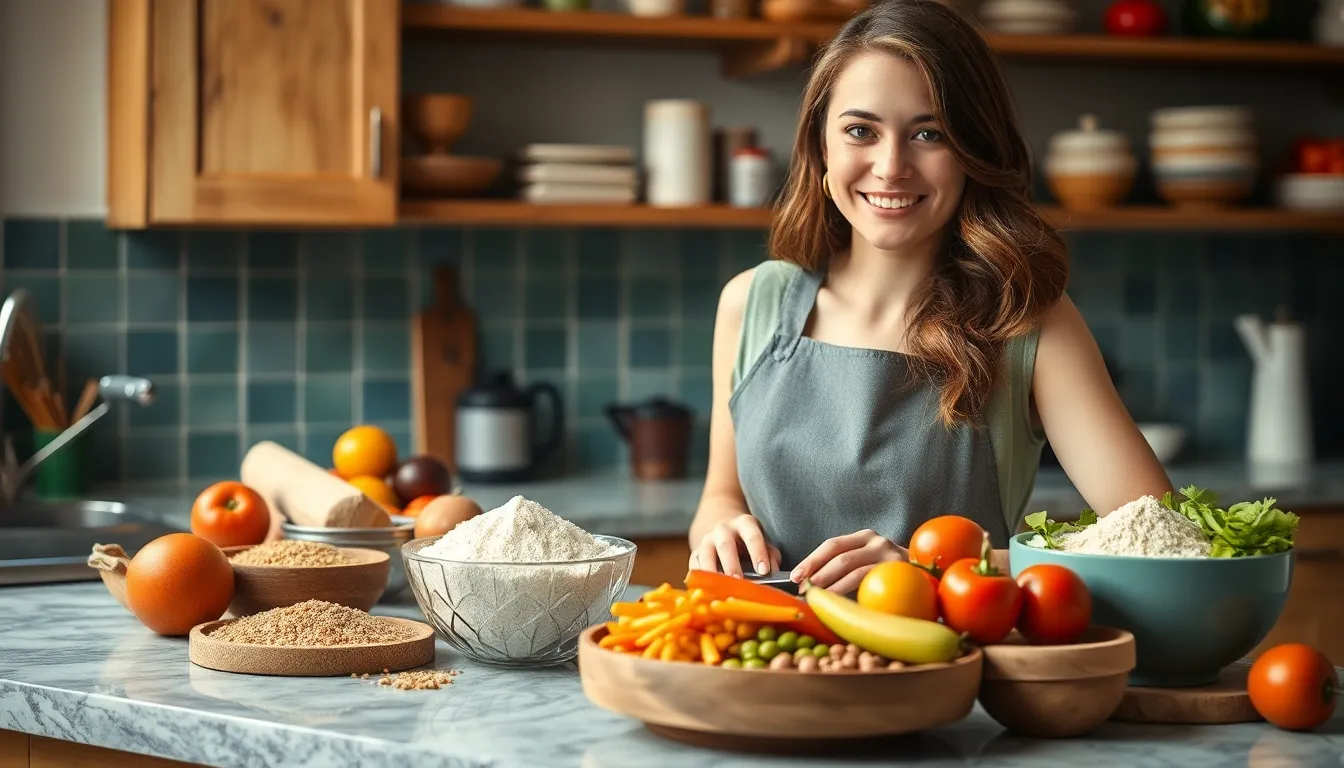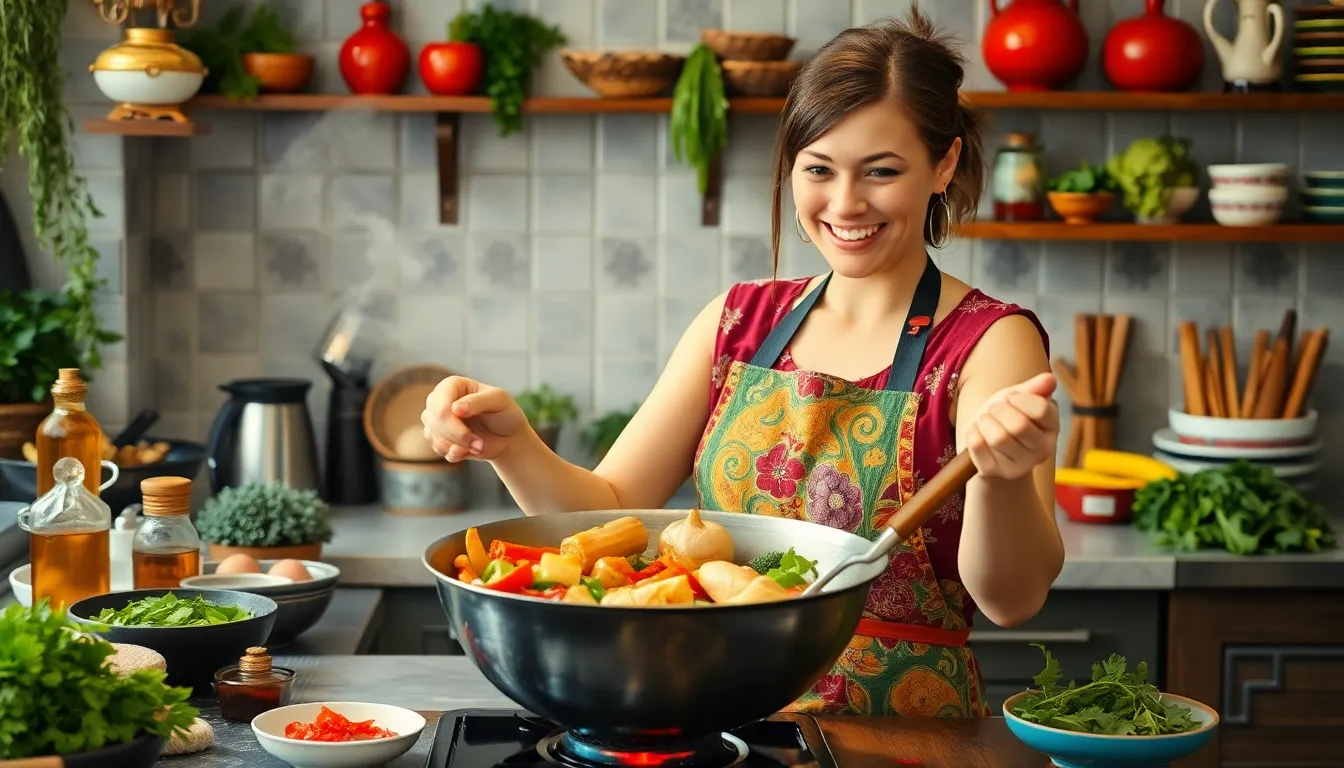In a world where gluten seems to sneak into everything from bread to that seemingly innocent soy sauce, finding delicious gluten-free recipes can feel like searching for a needle in a haystack. But fear not! Whether you’re gluten-sensitive or just looking to shake things up in the kitchen, there’s a treasure trove of mouthwatering dishes waiting to be discovered.
Table of Contents
ToggleUnderstanding Gluten-Free Diets
Gluten-free diets focus on eliminating gluten, a protein found in wheat, barley, and rye. Many people adopt these diets for health reasons or personal preferences.
What Is Gluten?
Gluten is a protein that helps foods maintain their shape. It provides elasticity and acts as a binder in products like bread and pasta. Wheat, barley, and rye are the primary grains containing gluten. While gluten is beneficial for many, it can trigger adverse reactions in some individuals, prompting a need for dietary adjustments.
Reasons for Going Gluten-Free
People pursue gluten-free diets for various reasons. Those with celiac disease must avoid gluten to prevent serious health complications. Non-celiac gluten sensitivity can also lead to discomfort and digestive issues. Some choose gluten-free options to explore new flavors and cuisines. Dietary preferences and health considerations play crucial roles in this decision for many individuals.
Benefits of Gluten-Free Recipes

Gluten-free recipes offer numerous advantages, catering not just to specific dietary needs but also to taste preferences. Exploring gluten-free options can lead to a healthier lifestyle overall.
Health Advantages
Gluten-free diets significantly benefit individuals with celiac disease or gluten sensitivity. Eliminating gluten can help reduce inflammation and associated symptoms. For those without these conditions, a gluten-free diet may encourage the consumption of whole foods like fruits, vegetables, and lean proteins. These foods provide essential nutrients and support overall health. Research from the National Foundation for Celiac Awareness indicates that many find relief from digestive issues upon going gluten-free. Weight management improves for some, as gluten-free products tend to contain fewer empty calories.
Enhanced Digestion
Improved digestion represents another appealing benefit of gluten-free recipes. Many experience relief from bloating and discomfort after removing gluten-containing foods from their diets. Foods rich in fiber, such as legumes and whole grains, often replace gluten-rich options, fostering healthier gut function. A balanced gluten-free meal plan encourages the intake of probiotics from fermented foods, which can promote a healthy microbiome. Identifying gluten as the trigger for digestive discomfort allows individuals to make informed dietary choices, resulting in better overall gut health. By focusing on gluten-free recipes, individuals often discover new ingredients that enhance their meals and improve digestion.
Essential Ingredients in Gluten-Free Cooking
Understanding essential ingredients makes gluten-free cooking straightforward. This knowledge empowers cooks to create satisfying dishes without gluten-containing products.
Gluten-Free Flours
Gluten-free flours serve as the backbone in many recipes. Almond flour, made from finely ground almonds, adds moisture and flavor. Coconut flour absorbs moisture effectively and provides a subtle sweetness. Rice flour offers a neutral taste, making it versatile for various dishes. Oat flour, derived from ground oats, enhances texture while adding fiber. Using these flours in combination fosters better consistency and flavor profiles in baked goods.
Common Substitutes
Common substitutes enhance the range of gluten-free dishes. For pasta, using rice noodles or lentil pasta provides satisfying alternatives. Bread recipes often call for a mix of gluten-free flours instead of wheat flour. Traditional breadcrumbs can be replaced with crushed gluten-free cereal or ground nuts. Dairy can also see substitutes, such as almond milk or coconut yogurt, which add creaminess without gluten. These swaps maintain texture and taste while respecting dietary restrictions.
Popular Gluten-Free Recipes
Gluten-free recipes offer a diverse array of options for every meal of the day. Discover easy alternatives that cater to dietary needs without sacrificing taste.
Breakfast Ideas
Delicious breakfast options include quinoa porridge, made with almond milk and topped with fresh fruits and nuts. Smoothie bowls add variety, incorporating gluten-free granola and seeds for crunch. Scrambled eggs served with sautéed spinach and gluten-free toast provide a hearty start. Chia seed pudding, infused with vanilla and honey, presents a satisfying, nutritious choice. Prepare these dishes to kick off the day with energy and flavor.
Lunch and Dinner Options
Hearty lunch ideas feature gluten-free wraps filled with roasted vegetables and hummus for a filling meal. Grilled chicken salad highlights mixed greens and an assortment of colorful veggies. Quinoa stuffed bell peppers blend protein and taste perfectly. For dinner, zoodles with marinara sauce stand as a popular pasta alternative, while curry made with coconut milk invites richness. Each recipe focuses on flavor while maintaining gluten-free integrity.
Snacks and Desserts
Tasty snacks can include roasted chickpeas seasoned with spices for a crunchy treat. Fruit and yogurt parfaits layer flavors and textures while remaining gluten-free. Energy balls made from oats, peanut butter, and honey serve as quick bites for busy days. For dessert, flourless chocolate cake satisfies chocolate cravings without gluten. These options ensure ample choices are available for any time of day.
Tips for Successful Gluten-Free Cooking
Successful gluten-free cooking hinges on understanding specific kitchen practices and making thoughtful recipe modifications. These strategies ensure delicious results without sacrificing taste or texture.
Kitchen Practices
In gluten-free cooking, cross-contamination prevention is crucial. Designate separate utensils and surfaces to avoid gluten exposure. Regularly check product labels for hidden gluten ingredients. Using fresh ingredients often leads to enhanced flavors. Measure ingredients accurately for consistent outcomes. Maintaining an organized workspace also streamlines the cooking process. When cooking gluten-free grains such as quinoa or rice, ensure thorough cleansing to remove potential gluten traces. This attention to detail fosters confidence in creating meals that satisfy dietary needs.
Recipe Modifications
Modifying traditional recipes to be gluten-free involves replacing key ingredients. Swap wheat flour with almond, coconut, or oat flour for similar textures. Different binding agents, like eggs or ground flaxseed, can replace gluten’s binding properties. When adapting sauces, choose gluten-free alternatives like tamari instead of soy sauce. Adding gluten-free starches, such as cornstarch or tapioca flour, helps thicken soups and sauces. Experimenting with liquid ratios during substitutions may yield better results. Adjusting baking times and temperatures ensures your baked goods rise properly while remaining moist.
Exploring gluten-free recipes opens up a world of culinary possibilities. Whether driven by health needs or a desire for new flavors, individuals can find satisfaction in a variety of dishes that cater to their dietary preferences.
With countless gluten-free ingredients available, cooking becomes an exciting adventure rather than a limitation. From breakfast to dessert, the options are diverse and delicious, ensuring that every meal can be enjoyable and fulfilling.
By embracing gluten-free cooking practices, anyone can create meals that not only taste great but also support overall health and well-being. It’s time to dive into the vibrant world of gluten-free cuisine and discover the joy of cooking without gluten.




